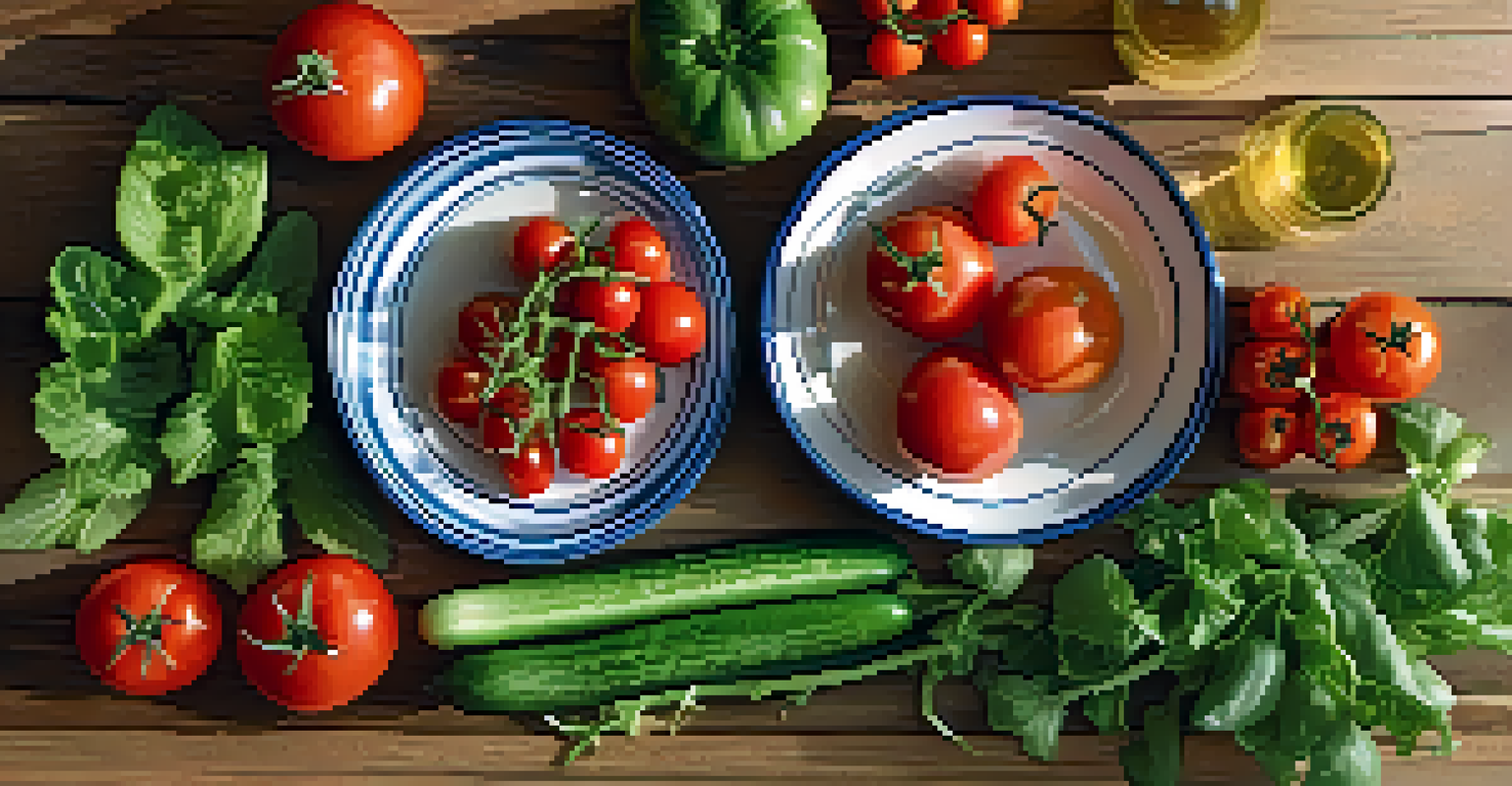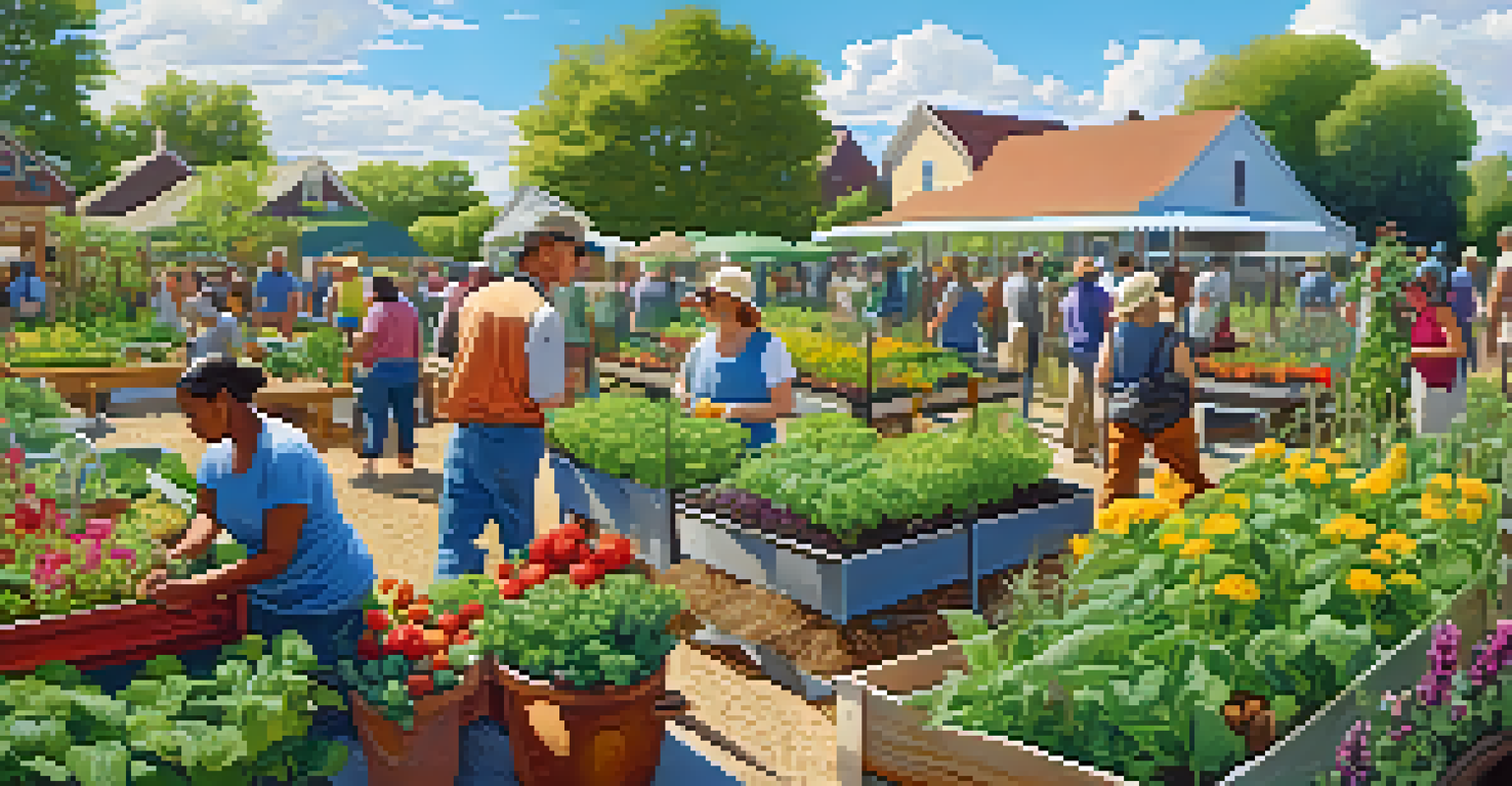Raw Food Diets and Urban Farming: A Sustainable Approach

Understanding Raw Food Diets and Their Benefits
A raw food diet consists mainly of unprocessed, whole foods that are typically not heated above 104-118°F. This approach emphasizes fresh fruits, vegetables, nuts, seeds, and sprouted grains, allowing individuals to enjoy the natural flavors and nutrients of their food. One of the main benefits of this diet is its potential to boost energy levels, as many people report feeling more vibrant and alert when consuming raw foods.
Let food be thy medicine and medicine be thy food.
Additionally, raw food diets are often rich in vitamins, minerals, and enzymes that can be lost during cooking. The high fiber content also aids in digestion and promotes a healthy gut. For those looking to improve their overall health and well-being, incorporating more raw foods can lead to positive lifestyle changes.
Moreover, raw food diets are aligned with sustainable living practices, as they encourage the consumption of locally sourced and seasonal produce. This not only reduces carbon footprints but also supports local farmers and economies. Thus, a raw food diet can be a delicious way to contribute to a more sustainable planet.
The Rise of Urban Farming in Modern Cities
Urban farming is gaining momentum as cities become more densely populated and the demand for fresh produce increases. This practice involves growing food in urban environments, such as rooftops, community gardens, and vacant lots, making fresh produce more accessible to city dwellers. Urban farming not only provides food but also helps build community connections and fosters a sense of belonging.

One of the key advantages of urban farming is its ability to minimize food miles— the distance food travels from farm to plate. By cultivating food within city limits, urban farmers can significantly reduce the environmental impact associated with transportation. This also translates to fresher produce, which is often harvested and sold on the same day, retaining maximum nutritional value.
Raw Diets Boost Energy and Health
A raw food diet emphasizes unprocessed foods, which can enhance energy levels and provide essential nutrients.
Additionally, urban farms often utilize sustainable practices such as composting, rainwater harvesting, and organic growing methods. Many urban farmers are increasingly aware of the environmental implications of their practices, leading to a greater emphasis on eco-friendly initiatives. As urban farming continues to grow, it presents a promising solution to food insecurity in urban areas.
The Connection Between Raw Food Diets and Urban Farming
Raw food diets and urban farming share a common thread: the commitment to fresh, unprocessed ingredients. Urban farms are ideal sources for the seasonal produce that raw food enthusiasts seek, creating a perfect marriage between the two practices. When individuals choose to support local urban farms, they not only gain access to fresh produce but also become part of a sustainable food system.
The greatest threat to our planet is the belief that someone else will save it.
In many urban farming initiatives, growers often employ organic methods, ensuring that the fruits and vegetables are free from synthetic pesticides and fertilizers. This organic approach aligns seamlessly with the principles of a raw food diet, where the focus is on purity and quality. As consumers become more conscious of their food choices, the demand for organic, locally grown produce is on the rise.
Furthermore, urban farms often incorporate educational programs that teach community members about nutrition and sustainable practices. These programs can empower individuals to adopt raw food diets by providing information on how to prepare and enjoy fresh produce. This creates a cycle of health, sustainability, and community that benefits everyone involved.
Environmental Benefits of Raw Foods and Urban Agriculture
Both raw food diets and urban agriculture play vital roles in promoting environmental sustainability. By consuming raw foods, individuals reduce their reliance on processed foods that often come with packaging waste and a high carbon footprint. Urban farming complements this by producing food close to where it’s consumed, cutting down on transportation emissions and waste.
Moreover, urban farms can enhance local biodiversity by providing habitats for pollinators and other wildlife. This can lead to healthier ecosystems and more resilient urban environments. The practice of growing food sustainably also encourages community stewardship of green spaces, creating a more pleasant atmosphere in cities.
Urban Farming Reduces Food Miles
By growing food within cities, urban farming minimizes transportation emissions and increases access to fresh produce.
As cities continue to grapple with issues like pollution and climate change, the combination of raw food diets and urban farming offers a hopeful and actionable path forward. By prioritizing a holistic approach to food systems, urban areas can reduce their environmental impact while fostering healthier communities.
Challenges of Adopting Raw Food Diets and Urban Farming
While the benefits of raw food diets and urban farming are compelling, there are challenges associated with both practices. For instance, not everyone finds it easy to transition to a raw food diet, as it may require a significant change in habits and meal preparation. Some individuals might struggle with finding the right balance of nutrients, especially protein and healthy fats, which are essential for a well-rounded diet.
Similarly, urban farming can face hurdles such as limited space, zoning regulations, and access to water. Many urban farmers work tirelessly to overcome these obstacles, but it often requires creativity, community support, and sometimes, policy changes to facilitate growth. Furthermore, the initial investment in setting up urban farms can deter potential growers from getting started.
Despite these challenges, many urban farmers and raw food advocates are finding innovative solutions to make both practices more accessible. Collaborations between local governments, community organizations, and individuals can lead to supportive policies and resources. By fostering a culture of collaboration, the movement towards raw food diets and urban farming can gain momentum and thrive.
How to Start Your Own Urban Garden for Raw Foods
Starting an urban garden can be an exciting and rewarding venture, especially if you're interested in a raw food diet. The first step is to assess your available space, whether it’s a balcony, rooftop, or community garden plot. Even small spaces can yield a surprising amount of produce with the right planning and care. Container gardening is a fantastic option for those with limited space, allowing you to grow herbs, vegetables, and even fruits.
Once you have your space identified, consider what types of raw foods you'd like to grow. Leafy greens, tomatoes, cucumbers, and herbs are great choices for beginners. Researching companion planting can also help maximize your yield and improve pest management. It’s important to choose crops that thrive in your local climate and soil conditions to ensure success.
Collaboration Fuels Sustainable Practices
Innovative partnerships between communities and local governments can make raw food diets and urban farming more accessible.
Additionally, be sure to incorporate sustainable practices from the start. This includes using organic seeds, natural pest control methods, and composting kitchen scraps to enrich your soil. As your urban garden flourishes, you’ll have a direct source of fresh, nutritious produce to enjoy in your raw food meals, making your journey toward a sustainable lifestyle even more fulfilling.
Inspiring Examples of Raw Food and Urban Farming Success
Around the world, there are inspiring stories of individuals and communities successfully merging raw food diets with urban farming. For instance, cities like New York and San Francisco have embraced urban farming initiatives that not only provide fresh produce but also educate residents about the benefits of eating raw. These initiatives often host workshops and events that encourage community involvement and awareness.
Another example is the rise of community-supported agriculture (CSA) programs, which connect local farmers with consumers eager to support sustainable practices. Many CSAs focus on providing raw, organic produce, making it convenient for members to access healthy foods. This model fosters a sense of community and trust between consumers and growers, reinforcing the idea that together, we can build a more sustainable food system.

These success stories illustrate the power of collaboration and innovation in promoting raw food diets and urban farming. By sharing resources, knowledge, and passion, communities can inspire one another to embrace healthier lifestyles and sustainable practices. As more people become aware of the benefits, the movement towards a greener, healthier future continues to grow.